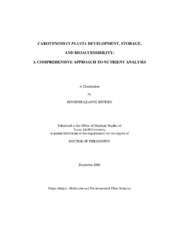Carotenoid In Planta Development, Storage, and Bioaccessibility: A Comprehensive Approach to Nutrient Analysis
Abstract
Plants contain a host of secondary metabolites that may be of dietary use to man. A comprehensive approach to plant-based nutrition would include investigating all aspects of a nutrient, from creation through storage and consumption. Here, experiments address each of these facets for a group of important antioxidant and pigment compounds, the carotenoids.
The carotenoid biosynthetic pathway regulatory mechanisms leading to lycopene accumulation are well defined in the model fruit, tomato. Those leading to accumulation of other carotenoids and flesh colors, however, are poorly understood. The variety of flesh colors available in watermelon fruit (red, orange, salmon yellow, and canary yellow) makes it an ideal candidate for investigating the regulation of the full pathway. Carotenoid accumulation was measured in ten watermelon varieties, representing the four flesh colors and three ploidy levels, throughout fruit maturation. It was found that the putative regulatory mechanisms controlling lycopene accumulation in red-fleshed fruit may be applied in a generalized fashion to each flesh color in respect to the major carotenoid accumulated at maturity. Additionally, triploid varieties were generally found to have higher accumulation levels than diploids, and tetraploids were intermediate to both. In addition to total carotenoid content, many factors are important in determining perceived benefit. Several of these factors involve components of the food matrix, cellular and subcellular species-specific characteristics of the food which act as barriers to nutrient release. Cell size, cell wall, and chromoplast (the carotenoid storage organelle) characteristics were observed in nine fruits and vegetables using light and transmission electron microscopy. Watermelon, tomato, and melon have the largest cells. Sweet potato, butternut squash, carrot, and mango have the most fibrous cell walls; mango and papaya additionally had the thickest walls. Chromoplast globular, tubular, crystalline, and membranous substructures were described for each food. These food matrix factors may be related to differences in carotenoid bioaccessibility between food sources. An in vitro digestion experiment was used to determine carotenoid bioaccessibility for each of these foods. Per serving, grapefruit yielded the most lycopene while carrot gave the most ?-carotene, ?-carotene, lutein, and phytoene, and mango proved a good source of violaxanthin.
Citation
Jeffery, Jennifer L. (2008). Carotenoid In Planta Development, Storage, and Bioaccessibility: A Comprehensive Approach to Nutrient Analysis. Doctoral dissertation, Texas A&M University. Available electronically from https : / /hdl .handle .net /1969 .1 /ETD -TAMU -2008 -12 -198.


